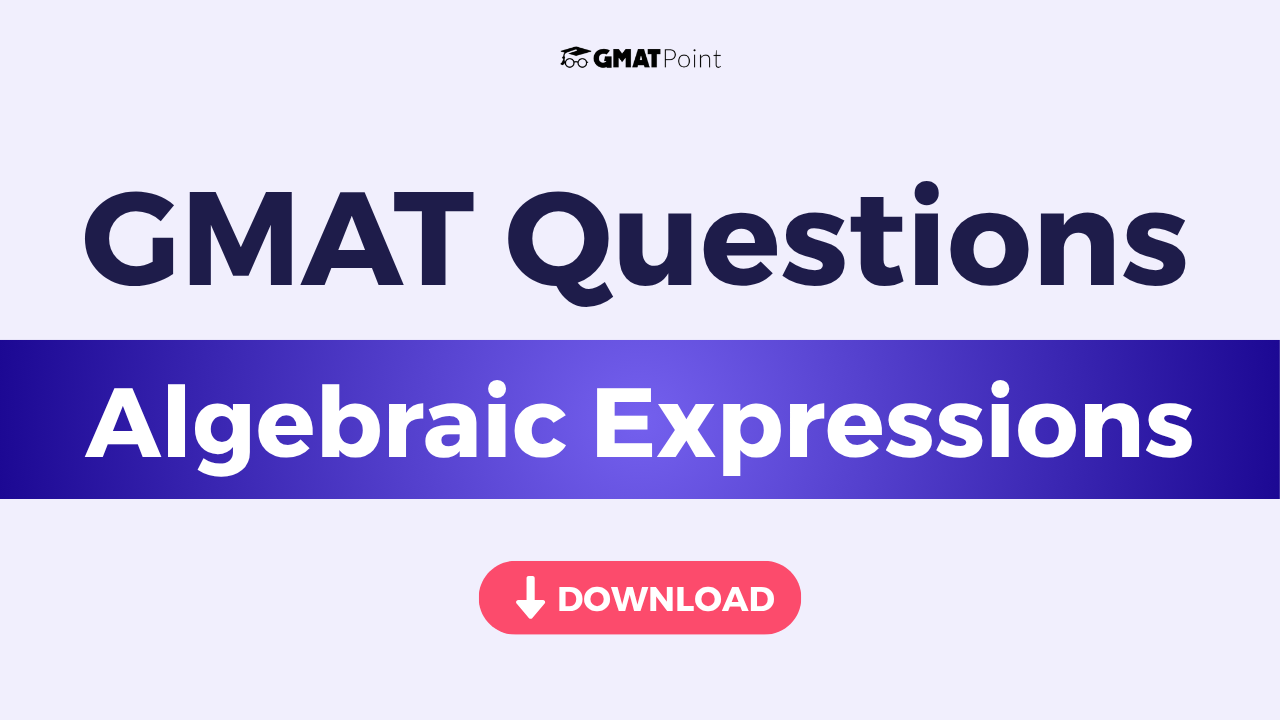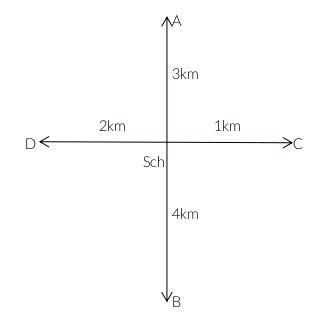GMAT Algebraic Expressions Questions With Solutions, Download PDF

GMAT Algebraic expressions form the foundation of many problems in the GMAT Quantitative section. With practice, you can Improve simplifying, factoring, and solving these expressions. By reviewingGMAT sample papers , you’ll get familiar with common question types. Using GMAT practice tests, you can improve your skills and track your progress. Additionally, download the free GMAT algebraic questions PDF with detailed solutions to ensure you're fully prepared. The more you practice, the more confident you'll become in solving algebraic expressions under timed conditions.
Question 1
If A’s playground is the one located at a distance of 3km from the school, then how far from the school is the playground located in the west?
correct answer:- 2
Question 2
If $$\frac{p^2}{q^2}+\frac{q^2}{p^2}$$=1 then the value of $$(p^{6}+q^{6})$$ is
correct answer:- 1
Question 3
If m - 5n = 2, then the vlaue of $$(m^{3} - 125n^{3}$$ - 30 mn) is
correct answer:- 3
Question 4
If $$\frac{4+3\sqrt{3}}{\sqrt{7+4\sqrt{3}}}= A+\sqrt{B}$$, then $$B-A$$ is
correct answer:- 3
Question 5
If $$a^{2}+1=a$$, then the value of $$a^{12}+a^{6}+1$$ is :
correct answer:- 4
Question 6
If $$p- 2q = 4$$, then the value of $$p^{3} - 8q^{3} - 24pq - 64$$ is :
correct answer:- 2
Question 7
If $$x+\frac{1}{x}=2$$ then the value of $$(x^2+\frac{1}{x^2})(x^3+\frac{1}{x^3})$$ is
correct answer:- 2
Question 8
If a, b, c be all positive integers, then the least positive value of $$a^{3} + b^{3} + c^{3} - 3abc$$ is
correct answer:- 3
Question 9
If $$a=\frac{2+\sqrt{3}}{2-\sqrt{3}}$$ and $$b=\frac{2-\sqrt{3}}{2+\sqrt{3}}$$, then the value of $$a^2+b^2+a \times b$$ is
correct answer:- 2
Question 10
If a + b + 1 = 0, then the value of $$(a^3 + b^3 +1 - 3ab)$$ is
correct answer:- 2
Question 11
If $$\frac{3-5x}{x} + \frac{3-5y}{y} + \frac{3-5z}{z} = 0 $$, the value of $$\frac{1}{x} + \frac{1}{y} + \frac{1}{z}$$ is
correct answer:- 2
Question 12
What number must be added to the expression $$16a^2 -12a$$ to make it a perfect square ?
correct answer:- 1
Question 13
Which of the following quadratic equations has equal roots?
correct answer:- 4
Question 14
The Simplified form of $$\frac{(b^{3}x^{2}a^{4}z^{3})\times(b^{4}x^{3}a^{3}z^{2})}{(a^{2}b^{4}z^{3})}$$ is
correct answer:- 3
Question 15
If a + b = 10 and ab = 24, then the value of $$a^3 + b^3$$ is
correct answer:- 1
Question 16
If 5x - 1 < 3x + 2 and 5x + 5 > 6 - 2x; then x can take which of the following values?
correct answer:- 2
Question 17
If $$x - y = -6$$ and $$x + y = 16$$, then $$x^2 - y^2$$ is?
correct answer:- 2
Question 18
Value of $$(4a^{2}+12ab+9b^{2}/(2a+3b)$$ is
correct answer:- 2
Question 19
If $$(x+y)^{2}=xy+1$$ and $$x^3 - y^3 = 1$$, then what is the value of x - y?
correct answer:- 1
Question 20
What is the value of $$\frac{1+x}{1-x^4}\div\frac{x^2}{1+x^2}\times x(1-x)$$ ?
correct answer:- 1
Question 21
Product of three consecutive odd numbers is 1287. What is the largest of the three numbers?
correct answer:- 3
Question 22
If a + b = 5 and ab = 6, then what is the value of $$a^{3} + b^{3}$$ ?
correct answer:- 3
Question 23
If a = 2 , b = -3 then the value of $$27a^3 - 54a^2b + 36ab^2 - 8b^3$$ is
correct answer:- 4
Question 24
If m + n = 1, then the value of $$m^3 + n^3 + 3mn$$ is equal to
correct answer:- 2
Question 25
If $$( x - 5)^{2}$$ + $$(y - 2)^{2}$$ + $$(z - 9)^{2}$$ = 0 , then value of (x + y - z) is
correct answer:- 3
Question 26
If x + 1/x = 6, then value of $$x^{2} + 1/x^{2}$$ is
correct answer:- 3
Question 27
If $$x + y + z = 0$$, then what is the value of $$\frac{(3y^2 + x^2 + z^2)}{(2y^2 - xz)}?$$
correct answer:- 1
Question 28
$$x, y$$ and $$z$$ are real numbers. If $$x^3 + y^3 + z^3 = 13,x + y + z = 1$$ and $$xyz = 1$$, then what is the value of $$xy + yz + zx?$$
correct answer:- 4
Question 29
If $$P = 7 + 4\surd3$$ and $$PQ = 1$$, then what is the value of $$\left( \frac{1}{P^2} \right) + \left(\frac{1}{Q^2}\right)$$?
correct answer:- 3
Question 30
If $$x - 4y = 0$$ and $$x + 2y = 24$$, then what is the value of $$\frac{(2x + 3y)}{(2x - 3y)}$$?
correct answer:- 2
Question 31
If $$(\frac{x}{a}) + (\frac{y}{b}) = 3$$ and $$(\frac{x}{b}) - (\frac{y}{a}) = 9$$, then what is the value of $$\frac{x}{y}$$?
correct answer:- 1
Question 32
If $$x = a + \frac{1}{a} and y = a - \frac{1}{a}$$ then $$\sqrt{x^4 + y^4 - 2x^2y^2}$$ is equal to:
correct answer:- 4
Question 33
If $$(8x^3 - 27y^3) \div (2x — 3y) = (Ax^2 + Bxy + Cy^2)$$, then the value of (2A + B - C) is:
correct answer:- 2
Question 34
If $$(x - 7)^3 + (x - 8)^3 + (x + 6)^3 = 3(x - 7)(x - 8)(x + 6)$$, then what is the value of $$x$$ ?
correct answer:- 2
Question 35
If $$ (x^{3}-y^{3}):(x^{2}+xy+y^{2})$$=5:1 and $$(x^{2}-y^{2}):(x-y)$$=7:1 then the value of 2x:3y equals
correct answer:- 2
Question 36
If a-$$\frac{1}{a-3}$$=5 then the value of $$(a-3)^{3}-\frac{1}{(a-3)^{3}}$$
correct answer:- 1
Question 37
if a+$$\frac{1}{b}$$ =b+$$\frac{1}{c}$$=c+$$\frac{1}{a}$$ where as a ≠ b ≠ c ≠ 0 then the value of $$a^{2}b^{2}c^{2}$$ is
correct answer:- 2
Question 38
If $$a^{2} + b^{2}+ c^{2} = 2(a - b - c) - 3$$, then the value of (a - b + c) is
correct answer:- 3
Question 39
If $$x^{a}.x^{b}.x^{c}= 1$$ then the value of $$a^{3} + b^{3}+ c^{3}$$is
correct answer:- 4
Question 40
If $$a^{4}+ a^{2}b ^{2}+ b^{4}$$ =8 and $$a^{2}+ ab+ b^{2}$$ = 4, then the value of ab is
correct answer:- 4
Question 41
If $$a = 25, b = 15, c = -10$$, then the value of $$\frac{a^3 + b^3 + c^3 - 3 abc}{(a-b)^2 + (b-c)^2 + (c-a)^2}$$ is
correct answer:- 4
Question 42
If $$a^{2}+b^{2}$$+$$\frac{1}{a^{2}}$$+$$\frac{1}{b^{2}}$$=4 then the value of $$a^{2}+b^{2}$$ will be
correct answer:- 3
Question 43
If $$x^{3} + 3 x^{2}+ 3x$$ = 7, then x is equal to
correct answer:- 3
Question 44
If $$x^2 + y^2 - 2x + 6y + 10 = 0$$, then the value of $$(x^2 + y^2)$$ is
correct answer:- 4
Question 45
What is the Simplified value of:
$$\frac{1}{8}\left\{\left(x + \frac{1}{y}\right)^2 - \left(x - \frac{1}{y}\right)^2\right\}$$
correct answer:- 1
Question 46
If $$x + \frac{1}{x} = 8$$, then find the value of $$\frac{5x}{x^2 + 1 - 6x}$$
correct answer:- 2
Question 47
If x + y = 4, xy = 2, y + z = 5, yz = 3, z + x = 6 and zx = 4, then find the value of $$x^3 + y^3 + z^3 — 3xy$$.
correct answer:- 3
Question 48
If $$p + \left(\frac{1}{p}\right) = 2$$ find the value of $$p \times p \times p$$
correct answer:- 3
Question 49
If $$x + \frac{4}{x} - 4 = 0$$, then the value of $$x^2 - 4$$ is equal to:
correct answer:- 1
Question 50
If $$A = \frac{x - 1}{x + 1}$$, then the value of $$A - \frac{1}{A}$$ is:
correct answer:- 4
Related Articles for Algebra
